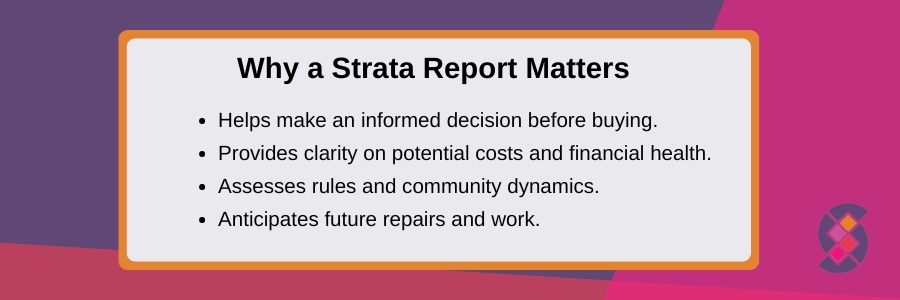What to Look for in a Strata Report
In any property purchase, buyers should always do their research on the various aspects of the property to get a full picture of what they will be buying into. This is no different for strata property purchases.
When looking to buy a strata property, it’s considered good practice to obtain and review a strata report – they usually cover the condition and circumstances of the strata scheme. This article will cover the key aspects of what to look for in a strata report, the significance of each aspect to buyers, as well as how to get a strata report.
Although the terminology in most of Australia is ‘strata report’, please note that in South Australia this refers to the Section Search contained in the Form 1 that is provided to purchasers from the conveyancer/lawyer.

What is a strata report?
Due diligence is one thing, but strata reports can also provide a general overview of the suitability of a strata scheme for purchase.
A strata report reveals important insights into the status of a strata building including its financial health, planned building works, and tenant disputes.
In South Australia, the Strata and Community Titles Act states that the body corporate must keep most records and correspondence received or sent by the corporation for a period of 7 years.
A strata report will include a range of information surrounding the strata scheme, usually consisting of:
- Any Contribution payable by the lot (including Arrears)
- Assets and Liabilities of the corporation
- Expenditure that the corporation has incurred, or resolved to incur
- Minutes of general and committee meetings for past two years
- Last statement of accounts of the corporation
- Current articles (Community only)
- Current policies of insurance
With a detailed review, a strata report can paint buyers a clearer picture of what it’s like to live in or own a strata property in the scheme.
Key things to look for in a strata inspection report
Financial health
One of the most important things to look out for in the strata report is a healthy bank balance. Like most properties, strata buildings will require maintenance and repair work over time, especially for common property areas. The cost of these works is covered by funds from the strata’s sinking fund (where held), which is supplied by the regular fees paid by owners.
However, simply having a large amount in the sinking fund alone is not an indication of a healthy balance. If the strata’s sinking fund is insufficient to cover the cost of required building work, owners may be charged an additional fee, known as a special levy. Strata reports that showcase a poor ability to cover forecasted capital works or a repeated history of raising special levies may indicate that buyers will have to bear the brunt of increased costs if they choose to buy into the scheme.
By-laws
Reviewing the by-laws of a community scheme can reveal a lot about the kind of living it offers. By-laws basically dictate what is allowed for all owners and tenants — whether pets are allowed in units, concessions for renovation work, smoking rules, and so on.
Each community scheme will have its own specific set of by-laws, whereas most strata schemes will have standard articles. Reviewing the strata report will enable buyers to understand what kind of rules are in place as well as how they will impact their desired lifestyle.

Building defects or scheduled work
Strata properties may have existing building defects or scheduled building work that will invariably impact the living environment for residents. Apart from being a major source of inconvenience, such building works can also pose high financial costs for owners in the form of special levies.
Strata reports will include historical information about the scheme’s past and future building works — frequent building work can sometimes be a sign of ongoing issues in the building but equally can sometimes be a sign that a building is being maintained in a proactive manner.
Community disputes and management
In strata communities, some friction between owners and residents is inevitable. How community disputes are dealt with, however, can make a big difference. Sometimes records of disputes in minutes and resolutions in a strata report can provide buyers with an indication of how the community gets along with one another, as well as how well and quickly disputes are resolved. Evidence of frequent quarrels between community members or external mediation services may be a sign of potential problems down the line.
How to get a strata report
Section searches (as they are called in South Australia) are legally required to be provided to purchasers, by the conveyancer. So purchasers should automatically receive one before signing a contract.
All in all, strata reports are an essential part of the due diligence process for potential buyers. Having all of the required information on hand can make a big difference in the purchasing process.



